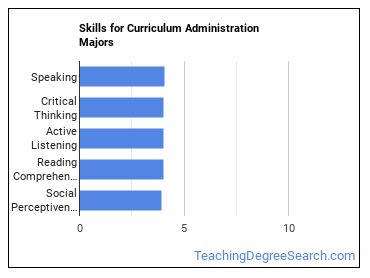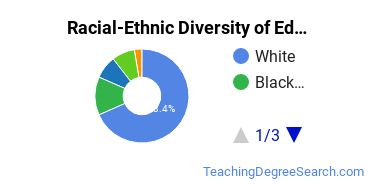Educational, Instructional, & Curriculum Supervision
Types of Degrees Educational, Instructional, & Curriculum Supervision Majors Are Getting
The following table lists how many educational, instructional, & curriculum supervision graduations there were for each degree level during the last year for which data was available.
| Education Level | Number of Grads |
|---|---|
| Master’s Degree | 1,066 |
| Graduate Certificate | 367 |
| Doctor’s Degree | 143 |
| Bachelor’s Degree | 26 |
| Basic Certificate | 10 |
What Educational, Instructional, & Curriculum Supervision Majors Need to Know
In an O*NET survey, educational, instructional, & curriculum supervision majors were asked to rate what knowledge areas, skills, and abilities were important in their occupations. These answers were weighted on a scale of 1 to 5 with 5 being the most important.
Knowledge Areas for Educational, Instructional, & Curriculum Supervision Majors
This major prepares you for careers in which these knowledge areas are important:

- Customer and Personal Service - Knowledge of principles and processes for providing customer and personal services. This includes customer needs assessment, meeting quality standards for services, and evaluation of customer satisfaction.
- Administration and Management - Knowledge of business and management principles involved in strategic planning, resource allocation, human resources modeling, leadership technique, production methods, and coordination of people and resources.
- Education and Training - Knowledge of principles and methods for curriculum and training design, teaching and instruction for individuals and groups, and the measurement of training effects.
- English Language - Knowledge of the structure and content of the English language including the meaning and spelling of words, rules of composition, and grammar.
- Personnel and Human Resources - Knowledge of principles and procedures for personnel recruitment, selection, training, compensation and benefits, labor relations and negotiation, and personnel information systems.
Skills for Educational, Instructional, & Curriculum Supervision Majors
When studying educational, instructional, & curriculum supervision, you’ll learn many skills that will help you be successful in a wide range of jobs - even those that do not require a degree in the field. The following is a list of some of the most common skills needed for careers associated with this major:

- Speaking - Talking to others to convey information effectively.
- Active Listening - Giving full attention to what other people are saying, taking time to understand the points being made, asking questions as appropriate, and not interrupting at inappropriate times.
- Critical Thinking - Using logic and reasoning to identify the strengths and weaknesses of alternative solutions, conclusions or approaches to problems.
- Reading Comprehension - Understanding written sentences and paragraphs in work related documents.
- Social Perceptiveness - Being aware of others' reactions and understanding why they react as they do.
Abilities for Educational, Instructional, & Curriculum Supervision Majors
Some of the most crucial abilities to master while a educational, instructional, & curriculum supervision student include the following:

- Oral Expression - The ability to communicate information and ideas in speaking so others will understand.
- Oral Comprehension - The ability to listen to and understand information and ideas presented through spoken words and sentences.
- Written Expression - The ability to communicate information and ideas in writing so others will understand.
- Written Comprehension - The ability to read and understand information and ideas presented in writing.
- Deductive Reasoning - The ability to apply general rules to specific problems to produce answers that make sense.
What Can You Do With a Educational, Instructional, & Curriculum Supervision Major?
Below is a list of occupations associated with educational, instructional, & curriculum supervision:
| Job Title | Job Growth Rate | Median Salary |
|---|---|---|
| Distance Learning Coordinators | 10.7% | $82,850 |
| Education Administrators, Elementary and Secondary School | 7.9% | $95,310 |
| Education Administrators, Preschool and Childcare Center/Program | 10.8% | $47,940 |
| Fitness and Wellness Coordinators | 10.7% | $82,850 |
| Postsecondary Education Administrators | 10.1% | $94,340 |
Who Is Getting a Bachelor’s Degree in Educational, Instructional, & Curriculum Supervision?
Racial-Ethnic Diversity
At the countrywide level, the racial-ethnic distribution of educational, instructional, & curriculum supervision majors is as follows:

| Race/Ethnicity | Number of Grads |
|---|---|
| Asian | 0 |
| Black or African American | 3 |
| Hispanic or Latino | 4 |
| White | 17 |
| International Students | 1 |
| Other Races/Ethnicities | 1 |
Geographic Diversity
Educational, Instructional, & Curriculum Supervision appeals to people across the globe. About 3.8% of those with this major are international students.
Amount of Education Required for Careers Related to Educational, Instructional, & Curriculum Supervision
Some degrees associated with educational, instructional, & curriculum supervision may require an advanced degree, while others may not even require a bachelor’s in the field. Whatever the case may be, pursuing more education usually means that more career options will be available to you.
Find out what the typical degree level is for educational, instructional, & curriculum supervision careers below.

| Education Level | Percentage of Workers |
|---|---|
| High School Diploma - or the equivalent (for example, GED) | 6.7% |
| Post-Secondary Certificate - awarded for training completed after high school (for example, in agriculture or natural resources, computer services, personal or culinary services, engineering technologies, healthcare, construction trades, mechanic and repair technologies, or precision production) | 1.2% |
| Some College Courses | 3.9% |
| Associate’s Degree (or other 2-year degree) | 6.3% |
| Bachelor’s Degree | 22.3% |
| Post-Baccalaureate Certificate - awarded for completion of an organized program of study; designed for people who have completed a Baccalaureate degree but do not meet the requirements of academic degrees carrying the title of Master. | 2.0% |
| Master’s Degree | 36.2% |
| Post-Master’s Certificate - awarded for completion of an organized program of study; designed for people who have completed a Master’s degree but do not meet the requirements of academic degrees at the doctoral level. | 8.0% |
| First Professional Degree - awarded for completion of a program that: requires at least 2 years of college work before entrance into the program, includes a total of at least 6 academic years of work to complete, and provides all remaining academic requirements to begin practice in a profession. | 0.6% |
| Doctoral Degree | 11.6% |
| Post-Doctoral Training | 2.1% |
Online Educational, Instructional, & Curriculum Supervision Programs
The following table lists the number of programs by degree level, along with how many schools offered online courses in the field.
| Degree Level | Colleges Offering Programs | Colleges Offering Online Classes |
|---|---|---|
| Certificate (Less Than 1 Year) | 0 | 0 |
| Certificate (1-2 years) | 3 | 1 |
| Certificate (2-4 Years) | 1 | 0 |
| Associate’s Degree | 1 | 0 |
| Bachelor’s Degree | 29 | 13 |
| Post-Baccalaureate | 0 | 0 |
| Master’s Degree | 70 | 28 |
| Post-Master’s | 31 | 0 |
| Doctor’s Degree (Research) | 12 | 2 |
| Doctor’s Degree (Professional Practice) | 0 | 0 |
| Doctor’s Degree (Other) | 0 | 0 |
Explore Major by State
Alabama
California
District of Columbia
Idaho
Kansas
Maryland
Mississippi
Nevada
New York
Oklahoma
South Carolina
Utah
West Virginia
Alaska
Colorado
Florida
Illinois
Kentucky
Massachusetts
Missouri
New Hampshire
North Carolina
Oregon
South Dakota
Vermont
Wisconsin
Majors Related to Educational, Instructional, & Curriculum Supervision
You may also be interested in one of the following majors related to educational, instructional, & curriculum supervision.
References
*The racial-ethnic minorities count is calculated by taking the total number of students and subtracting white students, international students, and students whose race/ethnicity was unknown. This number is then divided by the total number of students at the school to obtain the racial-ethnic minorities percentage.
- College Factual
- College Scorecard
- National Center for Education Statistics
- O*NET Online
- U.S. Bureau of Labor Statistics
- Usual Weekly Earnings of Wage and Salary Workers First Quarter 2020
- Image Credit: By Shai-WMIL under License
More about our data sources and methodologies.
